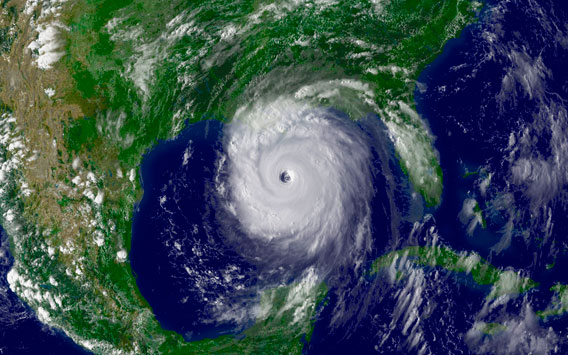Carbon Debt
Researchers say that if unchecked, carbon emissions will cost trillions of dollars annually by the end of the century
By Helene Ragovin
If global warming continues at its current pace, it will cost the United States some $1.9 trillion annually by the end of this century, according to calculations by two Tufts researchers.

Hurricane Katrina on August 28, 2005. By 2100, the U.S. will likely need to spend at least 1.8 percent of its gross domestic product to meet the costs of hurricane damages, real-estate losses and increased energy and water needs if carbon emissions are not decreased, researchers say. Photo: NOAA
Frank Ackerman and Elizabeth A. Stanton, who are with the Global Development and Environment Institute and the Stockholm Environmental Institute at Tufts, examined the economic impact of unchecked climate change. Their report, commissioned by the National Resources Defense Council (NRDC) and released in late May, concludes that under a "business-as-usual" environmental scenario, by 2100 the United States will likely need to spend at least 1.8 percent of its gross domestic product to meet the costs of hurricane damages, real-estate losses and increased energy and water needs.
Other associated costs could drive the number as high as 3.6 percent of the gross domestic product, the report says. All costs were calculated using 2008 dollars.
Some impacts, though, are beyond calculation. "There are human lives that are lost to climate change," says Ackerman. "There is the loss of endangered species; the loss of unique habitats; of unique locations that people value that you can't recreate. What's the price of the polar bear, of the coral reef? What's the price of losing the Everglades? A few hundred thousand more lives to violent storms? The damage goes far beyond the dollar value, and the dollars are bad enough."
The report breaks major climate-change damage into four categories:
- Hurricane damage, caused by the increasing intensity of Atlantic and Gulf coast storms, is estimated at $422 billion annually by 2100.
- Damaged or destroyed real estate as a result of rising sea levels will cost roughly $360 billion.
- Increased demand for energy to provide air conditioning and refrigeration, which will not be offset by reduced heating costs, are estimated at $141 billion.
- And the need to provide additional water, primarily in western states as climate change exacerbates drought conditions and disrupts existing water supplies, is priced at $950 billion.
The report also predicts that based on scientific forecasts, average temperatures in most of the country will rise 13 degrees Fahrenheit, leaving the Boston of 2100, for example, feeling more like the Memphis of today.
While the NRDC report looked only at the effects on the U.S. economy, "the impact on the rest of the world is sure to be even greater in proportional terms," Ackerman says. "The U.S. is colder and richer than most of the world. The hottest places will be the hardest hit first; the poorest nations will have the hardest time adapting."
For instance, another recent report for the Environmental Defense Fund by Ackerman and Stanton, with co-authors Ramón Bueno and Cornelia Herzfeld, examines the potential effect of global warming on the Caribbean. Hurricanes, they say, will cause widespread destruction of tourist sites and infrastructure, and in the worst-case scenario, the damage will cost the equivalent of 21 percent of gross domestic product annually in the region by 2100.
"The islands of the Caribbean are very close to sea level and are very much in the path of hurricanes," Ackerman said. "They are very dependent on tourism, which is very dependent on good weather. Global warming will do enormous damage to the Caribbean economies."
Helene Ragovin may be reached at helene.ragovin@tufts.edu.


